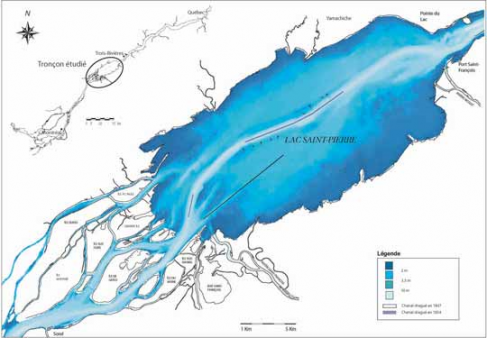Hopefully a sign of things to come for the tournament at Harts on July 31st! Speaking of which, details on that to follow…Stay tuned!
A Question of Light
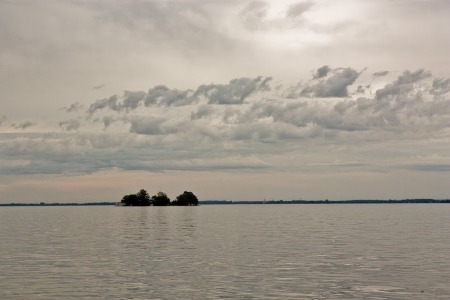
It’s no secret that walleye are sensitive to light. I do catch fish at all hours of the day but definitely put most of my larger fish in the boat at dusk or dawn. You will have an easier time finding fish, particularly big fish very early in the morning and very late in the day. I’m lucky enough to have a place on the water so fishing these prime times is practical. I can head out for a few hours in the morning, take the middle of the day to get some things done or enjoy the waterfront on hot days, have a nice dinner and head out for a few hours at dusk. Most of the large fish I put in the boat are caught after the sun has all but disappeared behind the horizon when the sky is light up with pinks and pastels. Not only is it prime walleye time, it’s the most beautiful part of the day to be out on the water.
Two other factors, also related to light penetration seem to play a role in triggering bites. The first is wind. I don’t like fishing those dead-calm situations. Fish become sluggish and here on Lake St. Francis there are more weeds floating in the water-column on calm days making fishing more difficult. At this time of year an evening wind is a welcome ally for another reason; shad flies. The wind helps reduce the number of shad flies you have to contend with. And trust me, that is a very good thing. I’ve had people ask me to take them in because they couldn’t handle the amount of shad flies crawling all over them. The second factor that seems to “turn ’em on” is cloud cover. The ideal situation is a relatively windy, cloudy day (see picture below). They are the days when walleye activity peaks and also when most people shy away from heading out, meaning you have your spots and quite often the entire lake to yourself.
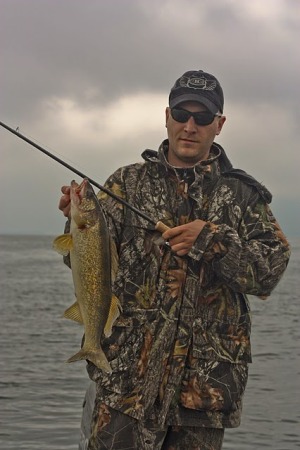
If you plan on fishing the evening bite this is the time of year to do it because dawn seems to drag on forever. Last night for example I was on the water until 10:15pm and there was still quite a bit of daylight left in the sky. One thing I highly recommend is keeping a tidy boat and preparing ahead for darkness on the water. I like to keep a head-lamp in my tackle box. They are inexpensive, very practical for fishing applications because they allow full use of your hands and the LED light will last you an entire season. Whether you’re re-tying, baiting, removing weeds, you name it these will quickly be worth the money you spent on them. They are also fantastic when you get back to shore. If there is a shortage of light near the boat-ramp you’ll love having these. You can find them anywhere they sell fishing, hunting and camping gear. Canadian Tire carries them too.
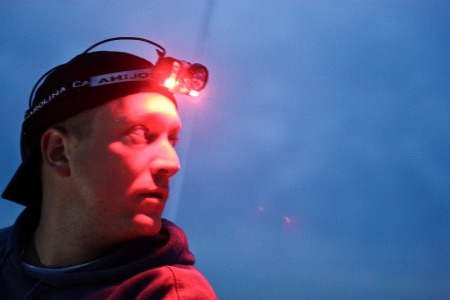
Another tool that has become indispensable for me is a decent GPS/Sonar unit, especially when venturing out at night. These units essentially combine 3 tools into 1; a contour/depth chart or map, a GPS system and of course a sonar unit. I can’t begin to explain how much I rely on this tool out on the water. This is especially true on a new body of water and again in conditions where your visibility is impaired (night, fog etc). The unit I own is the Eagle FishElite 500c and I absolutely love it. You will find that they are fairly expensive but believe me they quickly become worth their weight in gold. They are guaranteed to help you catch fish and navigate large bodies of water like St.Francis with ease and confidence. Keep in mind you need to purchase a separate chip/card with the maps and unfortunately they don’t come cheap. The detail of the maps and the sheer number of lakes on the chips explain their cost. They are very, very well made. Here’s a tip, take a look on Ebay and you can usually find pretty good deals out there. I ended up saving about a hundred bucks by shopping around a little.
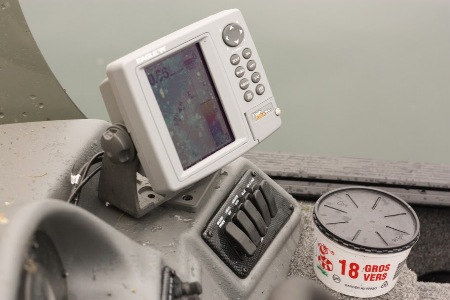
Getting out on the water for many of us is therapeutic. It’s something we cherish and look forward to. If you are like me and spend hours on the water making a few valuable purchases will enhance your enjoyment of the outdoors. To make the best out of your walleye fishing experience remember the basics, wind and cloud cover are allies and chances are peak activity levels will be at dusk or dawn so focus on these times if you can. Ultimately the end result is more toothy critters like this guy in your boat and more stories to share with your fishing buddies by the campfire.
Until next time, stay outside! Jigger.
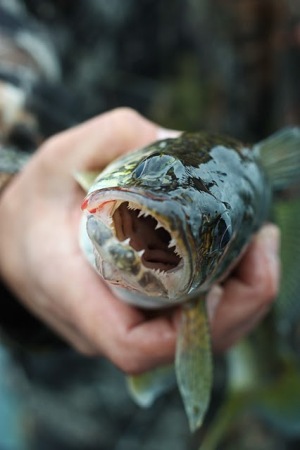
Summer Conditions in May = Adapation.
It’s a new season and I’m happy to be back on the water sharing my weekend adventures with you once again. It’s been a strange spring in Walleye land for me this year. The usual spawning runs were cut short by low river runoffs due to lack of snow in Ontario. Unseasonably high temperatures and little precipitation only made matters worse, although I’m certainly not complaining about the weather. This year we are seeing very low water levels in the St-Lawrence River system. Sure-fire areas where I normally catch fish into mid-to-late June look like they normally do in July. The shallow bays are already getting choked up with weeds and the water-skiers are out. They’re a bit overzealous if you ask me but out there nonetheless. However, as the old adage says, the fish are still there, and they have to eat. It took me a while longer than it normally does this year but after completely changing my approach, the result of a happy accident no less, I found a pattern that located the big boys who were only thinking about one thing; feeding.
A friend of mine pointed out that walleye were readily hitting tubes in the mouth of feeder rivers. He theorizes (as do I) that predatory fish in the St-Lawrence have developed a taste for Gobies, which are easily imitated with a tube and fat jig head. He was absolutely right, and although we did quite well numbers-wise on sandy flats adjacent to river mouths, the size of the fish wasn’t up to par. The largest walleye we caught on tubes was probably about 2.5lbs. We did catch about 40 fish in one morning on the first weekend and 25 or so but most were what I would consider small fish. Of course, they were tons of fun to catch on jigs and great eating, especially in the cold water. I kept my limit for the first two weekends of the season and had myself a feast fit for kings. There is nothing like fresh cold water walleye so if that’s what you’re into large sand flats where murky waters of feeder rivers meet the clear running waters of the St-Lawrence offer fantastic jigging opportunities where you can really rake in the numbers. That bite tapered off with the warming waters and fish moved on. So did I.
One thing to consider at this time of year is that you have a wider depth spectrum to work with. Although the water in the shallow bays is nearing 70 it’s far from the case in the cool, deeper, running waters of the open lake. This allows fish to move comfortably from deep pockets to shallow bars and humps to feed depending on how much light is penetrating the water column. I was fishing an area where two 30-foot holes are connected by a sandy saddle area that peeks at about 12 feet. After landing a few fish here and there in the deeper parts of the structure I sort of accidentally drifted over the shallow area and immediately landed a very respectable fish. Thinking this might be a fluke I reluctantly back-tracked and caught four more really nice walleye in the exact same spot within 45 minutes. This was in the middle of the afternoon also, however the North wind was chopping up the water quite a bit. Boat control was challenging to say the least.
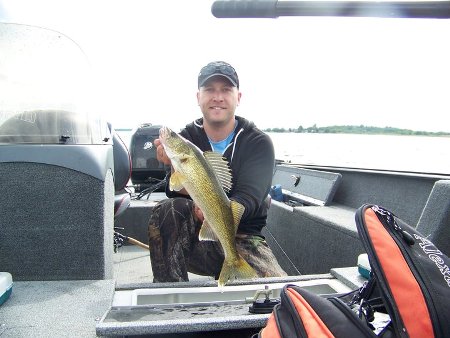
One thing I noticed is that paying attention to light conditions and sky colour really helps when trying to select the right size blade and colour for your spinners, crankbaits or jigs. For example, when confronted with a high sun in mid afternoon you might want to go with the silvers. Think of a baitfish reflecting the mid-day sunlight. Add a bit of cloud cover to the mix like yesterday and you will notice that purples and blues tend to stand out. Once the evening sun sets and the sky turns orangey-pink the chartreuse, gold and orange spinners really shine (no pun intended). The best way I can describe how to know which colour to use is that they will “jump out†at you if you pay attention to the colour of the sky and try to imagine how much light is penetrating in the water. Of course, if you are trying to mimic Gobies on bottom you’ll want something much more subtle.
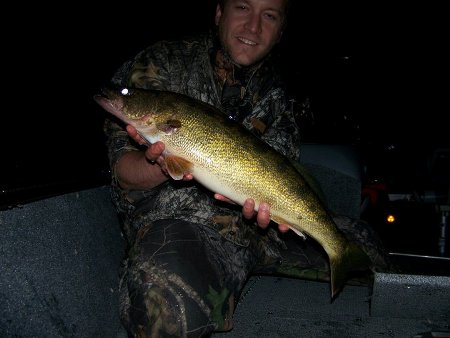
With a little adaptation to the early summer conditions this year and a little bit of experimentation I added another weapon to my walleye arsenal; shallow saddles in windy conditions and cold water. I also figured out that it pays to really focus in on detail like matching colour to surroundings, looking for fish in areas where you normally would not this time of year and adapting to conditions. Get out there and think outside the box a little. It’ll pay off. Just remember, if you’re not catching fish doing what you normally do you’re better off not catching any experimenting. At least you’re getting out there trying new tricks
Stay outside! Jigger.
Une pêche blanche au doré qui fait rêver!
Je me souviens des premières fois où j’ai eu la chance de voir à l’œuvre Al Lindner ou Bob Izumi ou encore Reno Viola bien installé devant la télévision le samedi matin. Étant tout jeune, ces expériences en pyjamas ont éveillé en moi une passion pour la pêche qui maintenant, ne fait qu’augmenter en ampleur à chaque année. The In-Fisherman (Al et Ron Lindner) en particulier était pour moi LA référence en matière d’information pour la pêche plus sérieuse. Leur approche systémique m’a permise d’augmenter considérablement mon taux de réussite ainsi que de capturer de plus gros spécimens avec une certaine régularité. D’après-moi, In-Fisherman qui est maintenant devenu « Lindner’s Angling Edge » en ondes sur WFN est nettement supérieur à la vaste majorité de programmes de pêche qui se contentent souvent d’une présentation très superficielle ou de la promotion de produits et de pourvoiries. On peut le comprendre. Après tout, « money is the name of the game », et ce dans toutes les facettes de la société d’aujourd’hui.
Permettez-moi de vous conter l’histoire d’un samedi matin bien ordinaire en tout début de la saison blanche. Il pleut et la glace du lac Saint-François ne m’inspire pas confiance donc je décide de m’installer devant la télé avec mon café pour savourer une émission de pêche ou deux. Malheureusement je constate rapidement que de nos jours les émissions de pêche sont plutôt des annonces publicitaires d’une demi-heure où l’on aperçoit des pêcheurs capturer poisson après poisson, sans trop d’explication et parfois avec de la musique qui ne fait qu’aliéner le téléspectateur de l’expérience vécue par les pêcheurs. C’est à ce moment que je me souviens d’un site dont parlait Jean Chartrand sur CKAC sur lequel je trouverais une vidéo de pêche sur glace au doré avec Luc Couture sur le lac Saint-Pierre. Je me suis dit, pourquoi ne pas aller regarder ça. Je me suis dirigé vers l’ordinateur et disons que je n’ai pas mis beaucoup de temps à être absolument estomaqué par la qualité exceptionnelle de cette vidéo. On parle ici de pêche blanche au doré «world-class ». Vous pouvez trouver ce bijou monté par Daniel Leclair et Jean-Guy Côté au www.peche-en-ligne.net
Je n’ai jamais eu la chance de pêcher au Lac St-Pierre mais croyez-moi j’ai l’intention de rectifier cette situation. J’imagine que ce plan d’eau ressemble quelque peu au Lac Saint-François malgré le fait que ce dernier ne soit pas aussi large et qu’il est un peu plus profond en moyenne que le lac Saint-Pierre. Toutefois, les deux plans d’eau étant tous deux des élargissements peu-profonds du Fleuve Saint-Laurent où le débit d’eau est contrôlé par des barrages hydro électriques, il y a certainement quelques parallèles à faire. Par exemple, le courant du fleuve doit y jouer un rôle primordial en créant une relation intime entre le courant du fleuve et les habitudes alimentaires du doré jaune. Les dorés du lac Saint-Pierre doivent eux aussi être paresseux, se contentant d’attendre la nourriture apportée par le courant dans des garde-mangers. D’ailleurs la description de la batture sur laquelle pêchaient Luc Couture, Daniel Leclair et Jean-Guy Côté me faisait beaucoup penser au type de batture que l’on retrouve à plusieurs endroits sur le lac Saint-François. Il s’agit d’une longue structure assez uniforme qui n’a pas de pointe à cibler comme tel, ni d’endroit qui attire le poisson en particulier comme un amas de roches par exemple. Une autre similitude entre les deux plans d’eaux est l’effet stimulant des navires qui passent régulièrement dans la voie maritime du Saint-Laurent sur les habitudes alimentaires des poissons prédateurs. Je n’y avais jamais pensé, mais avec l’absence de vagues pendant la saison hivernale cet effet pourrait être encore plus important. J’imagine que l’expérience des trois pêcheurs dans la vidéo était en fin de saison puisque la glace était très épaisse et que les navires commençaient à peine à passer. Un petit secret gardé bien gardé du lac Saint-François suggère que les dorés soient plus actifs suite au passage d’un navire dans la voie maritime. Je peux vous témoigner personnellement que certaines de mes plus belles prises sont survenues à de tels moments. En particulier très tard en soirée.
Pour revenir à la vidéo, au lieu de voir un gars prendre un poisson et de le remettre à l’eau pendant qu’un narrateur nous endort en perfectionnant sa prose, j’ai eu la très plaisante surprise d’être sujet à de maintes explications très claires des techniques utilisées, aux outils utilisés et surtout, à des résultats absolument époustouflants. On parle de dorés dont la taille moyenne se situe autour de 3-5lbs avec quelques monstres autour des 10lbs ainsi que d’un masquinongé et d’un esturgeon très respectables. Tout ceci fut jumelé à une forme de vidéographie que je nommerais «intégrale», ou, si vous le préférez «raw». On retrouve d’ailleurs sur le site un avertissement très clair qui indique qu’on ne fait pas affaire avec des experts de l’audio-vidéo. Je ne sais pas si l’intention en fut ainsi mais ce trait même donne au tout un cachet vraiment spécial. On relai l’expérience véritable de la journée aux auditeurs sans poupons et sans musique et narration distrayantes. C’est un véritable coup de vent rafraichissant. Bref, c’est du vrai, c’est pour les mordus, et je vous invite fortement à leur rendre visite.
Alors pour ceux et celles qui ne retrouvent plus la substance qu’ils recherchent dans les émissions de pêche et qui cherchent à en savoir plus long sur les endroits à privilégier autour des centres urbains, tout en apprenant les techniques à utiliser, la présentation de leurre, les habitudes saisonnières des poissons, je vous conseil de jeter un coup d’œil sur le site de Daniel Leclair et Jean-Guy Côté www.peche-en-ligne.net et à leur vidéos. Leur approche me rappelle celles des frères Lindners. Ils ont de la difficulté à cacher leur amour et passion pour le sport tout en nous fournissant de l’information utile et efficace. Car même si la pêche dans nos endroits peuplés est excellente, il est aussi très facile de rentrer bredouille sur ces imposants plans d’eau. Rien de mieux que des conseils d’experts pour se bâtir un peu de confiance!
On se voit sur l’eau, Jigger.


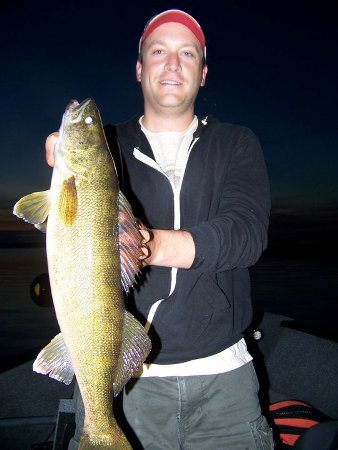
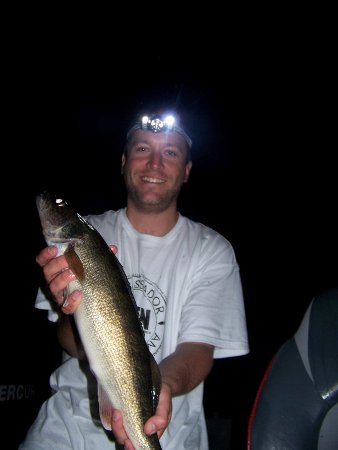
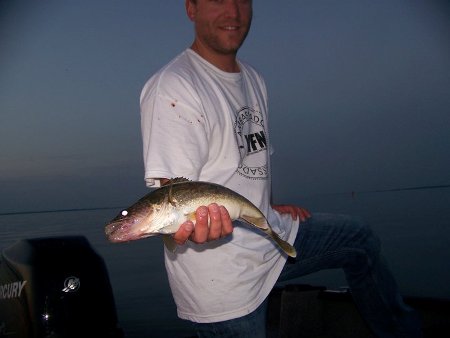
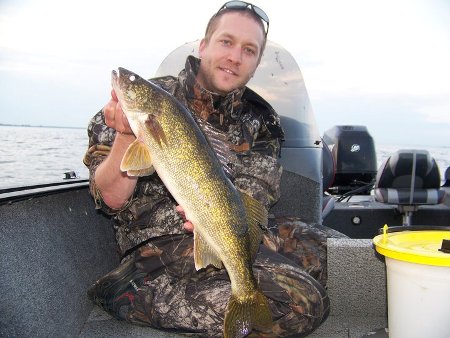
![Martin[1] Martin[1]](http://stfrancisjigger.com/wp-content/uploads/2010/01/Martin11-300x199.jpg)
![Luc_Daniel[1] Luc_Daniel[1]](http://stfrancisjigger.com/wp-content/uploads/2010/01/Luc_Daniel1-300x199.jpg)
